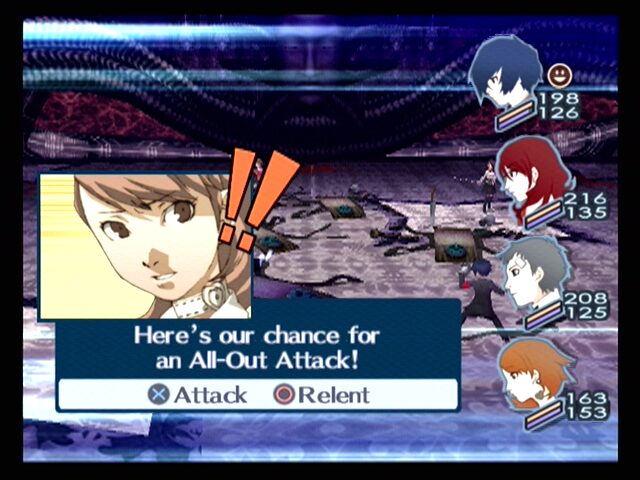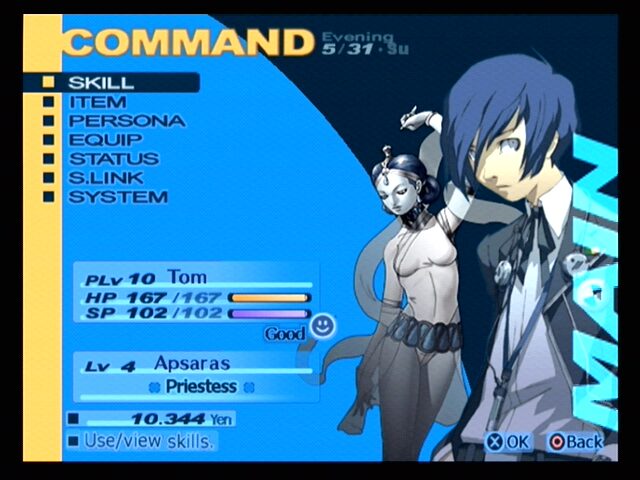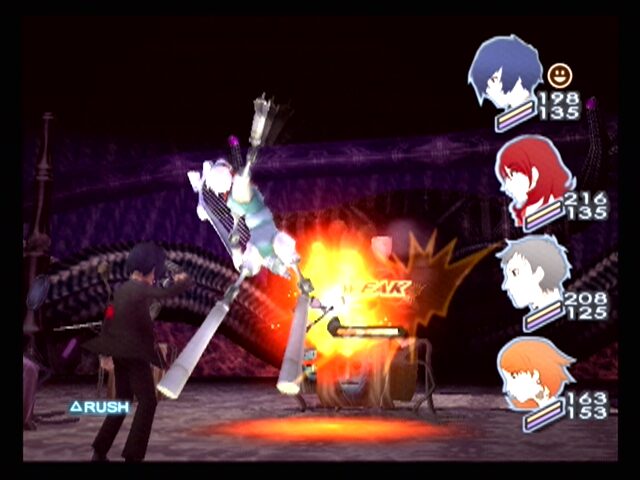Retro Replay Review
Gameplay
Persona 3 masterfully blends traditional turn-based JRPG mechanics with a robust life-simulation system, giving players two distinct modes of play. By day, you navigate the halls of Gekkoukan High School, attend classes, complete homework, and deepen bonds with classmates. These “social links” not only flesh out the characters you’ll spend midnight with, but also directly impact your combat abilities by powering up the Personas you can summon.
(HEY YOU!! We hope you enjoy! We try not to run ads. So basically, this is a very expensive hobby running this site. Please consider joining us for updates, forums, and more. Network w/ us to make some cash or friends while retro gaming, and you can win some free retro games for posting. Okay, carry on 👍)
When the clock strikes midnight, the real world freezes and the enigmatic tower known as Tartarus appears. Here, exploration turns tactical: battles follow the classic Megami Tensei model of demon-summoning, where you can equip weapons or call forth Personas—manifestations of your inner psyche—to strike at enemy weaknesses. Exploiting those weak points unleashes powerful “One More” combo attacks, rewarding strategic party composition and effective spell usage.
The Persona fusion system builds further depth, granting you Persona cards after each victory that can be combined to create stronger allies. By experimenting with different fusions, you uncover rare abilities and unique skill sets, encouraging multiple playthroughs. The seamless interweaving of daily life and nightly dungeon crawling results in a gameplay loop that feels both varied and endlessly engaging.
Graphics
For a PlayStation 2 title, Persona 3’s visuals hold up remarkably well. Character models are stylized with bold outlines and vibrant color palettes, giving each student and demon a distinct presence. The anime-inspired art direction shines in both cutscenes and in-battle animations, where Personas materialize in spectacular fashion.
The world design contrasts the bright, inviting corridors of Gekkoukan High with the eerie, ever-shifting floors of Tartarus. Each level of the tower has its own motif—dark stone, glowing runes, or mechanical hallways—that reinforce the sense of venturing deeper into an otherworldly threat. Even simple menu screens are polished with atmospheric artwork and thematic backdrops.
Lighting effects are used sparingly but effectively: moonlight filtering through classroom windows sets a melancholic mood, while spell effects during combat burst in vivid shades of blue, red, or green. Though lacking modern high-definition textures, the game’s strong graphic design and consistent visual style make it both memorable and distinctive.
Story
You step into the shoes of a transfer student who, after losing your parents, is sent to live on the remote Iwatodai island. On your first day in the new dormitory, you’re attacked by a shadowy monster and awaken with the power to summon a Persona—an archetypal being born from your psyche. This inciting incident thrusts you into a nightly investigation of the mysterious Midnight Hour, when shadows roam free.
The narrative unfolds over the school calendar, weaving everyday experiences with supernatural crises. As you form bonds with classmates and uncover their personal struggles, the story probes themes of death, loss, and the human will to overcome adversity. Your party members each possess their own hidden traumas and motivations, creating an emotional resonance as you fight side by side.
Antagonistic forces gradually reveal a darker conspiracy behind the shadows, tying personal tragedies to a larger cosmic threat. The balance between slice-of-life moments—holiday festivals, part-time jobs, heartfelt conversations—and intense dungeon battles makes the pacing feel dynamic. By the time the climactic revelations arrive, you’re fully invested in both the characters and the fate of the world they inhabit.
Overall Experience
Persona 3 stands out for its unique fusion of school simulator and dungeon-crawling RPG. The day-to-day schedule gives a genuine sense of progression and attachment to your peers, while the Midnight Hour ensures that every night brings new strategic challenges. This duality keeps the experience fresh, rewarding players who balance social calendars with combat readiness.
The soundtrack by Shoji Meguro further elevates the atmosphere, shifting seamlessly from upbeat school jingles to heavy rock tracks in battle. Voice acting—though limited to battle cries and key lines—adds extra personality to your team. Whether you’re forging a new social link or facing a fearsome shadow boss, the game’s audiovisual presentation consistently reinforces its themes.
For newcomers to the Megami Tensei franchise, Persona 3 provides an accessible entry point without sacrificing depth. Longtime fans will appreciate the evolutionary changes in Persona mechanics and the refined fusion system. With its memorable characters, compelling story, and addictive gameplay loop, Persona 3 remains a timeless JRPG that continues to captivate players years after its original release.
 Retro Replay Retro Replay gaming reviews, news, emulation, geek stuff and more!
Retro Replay Retro Replay gaming reviews, news, emulation, geek stuff and more!









Reviews
There are no reviews yet.